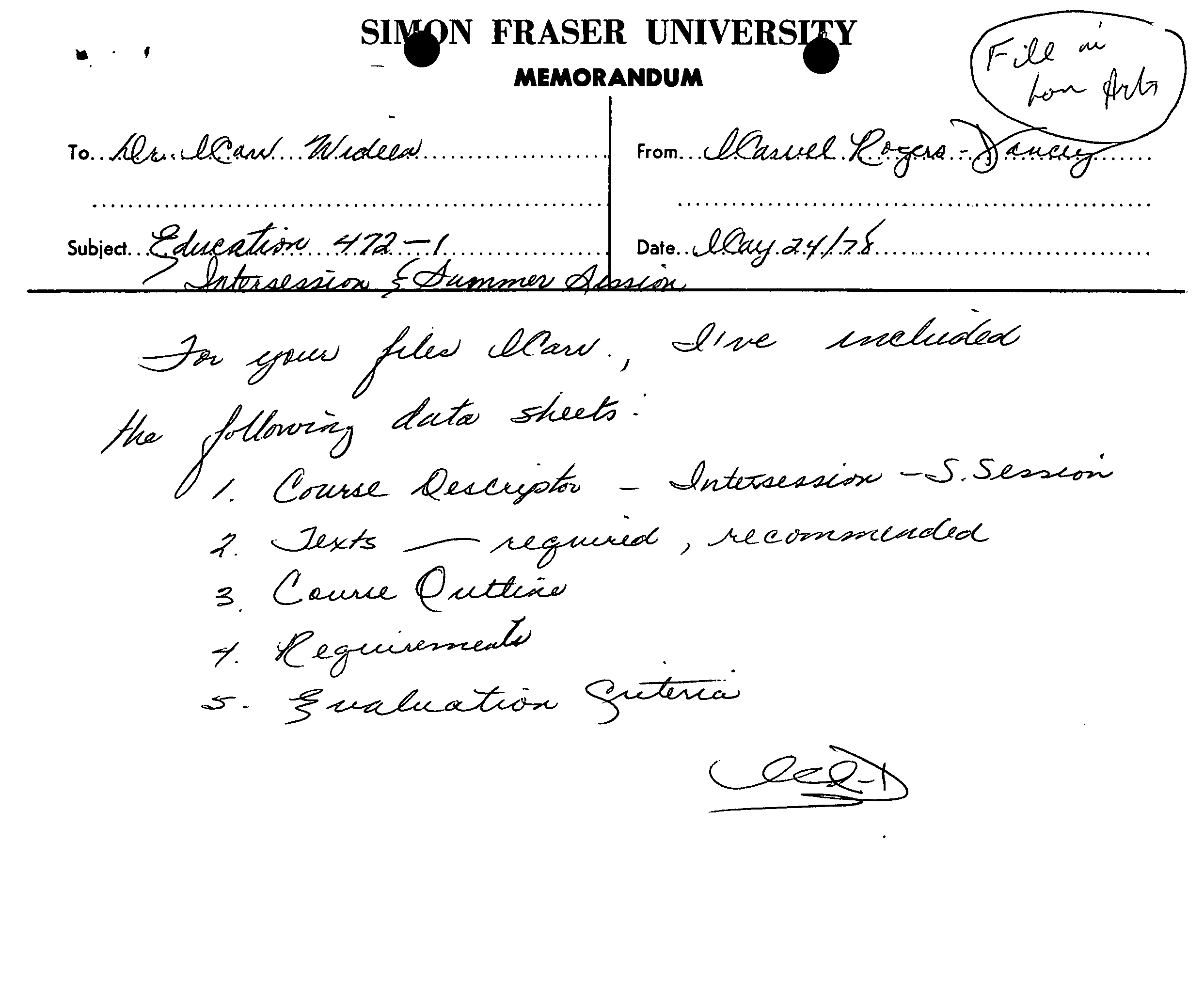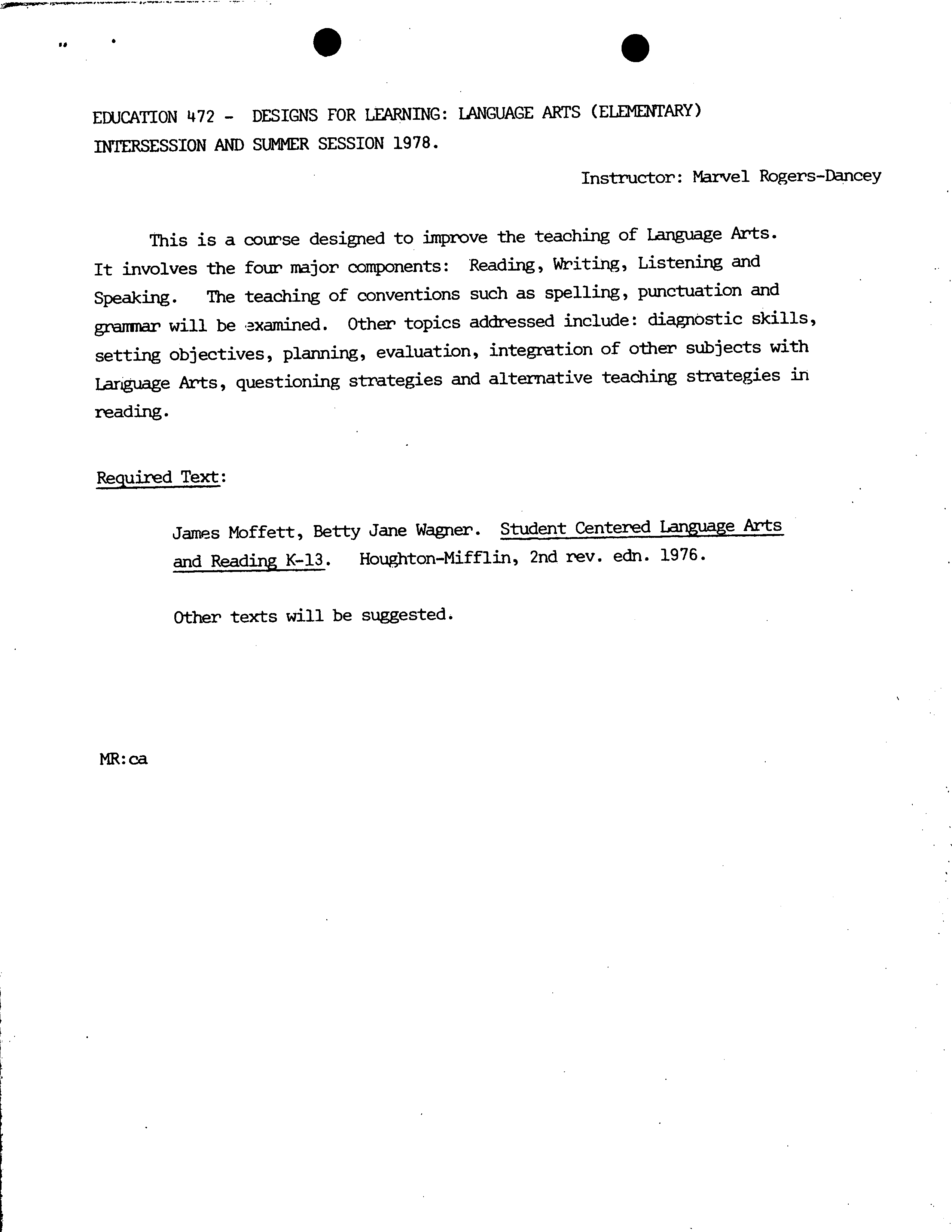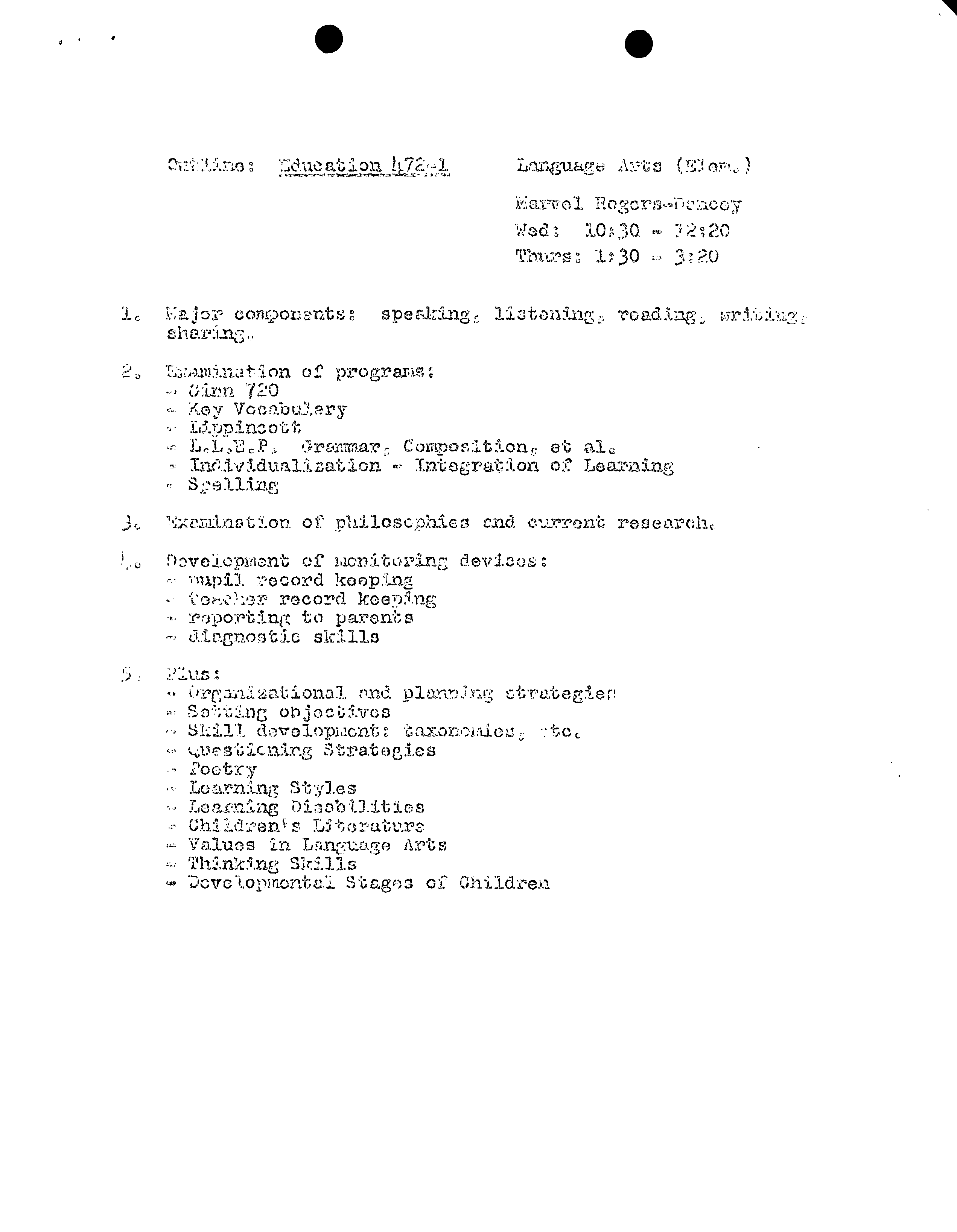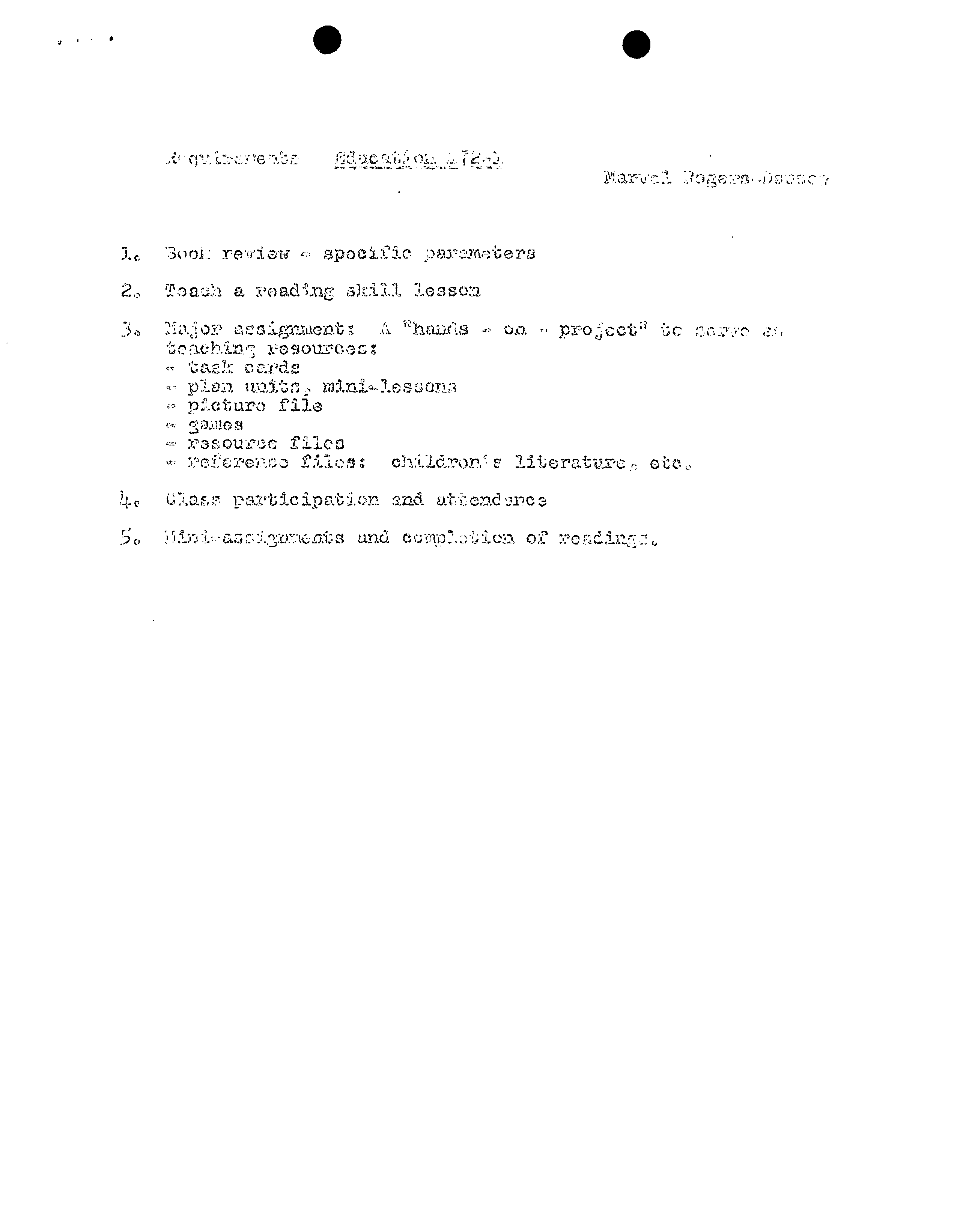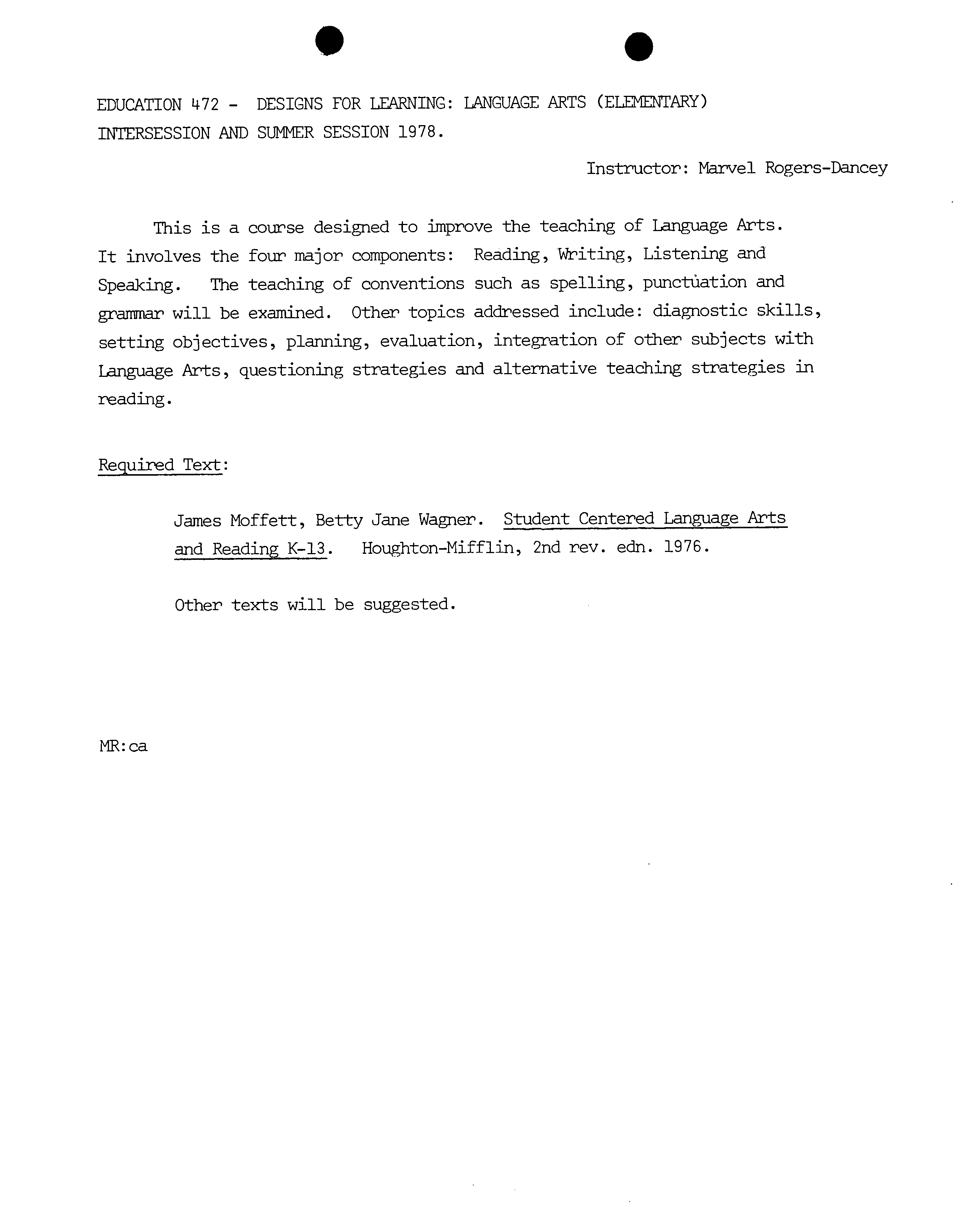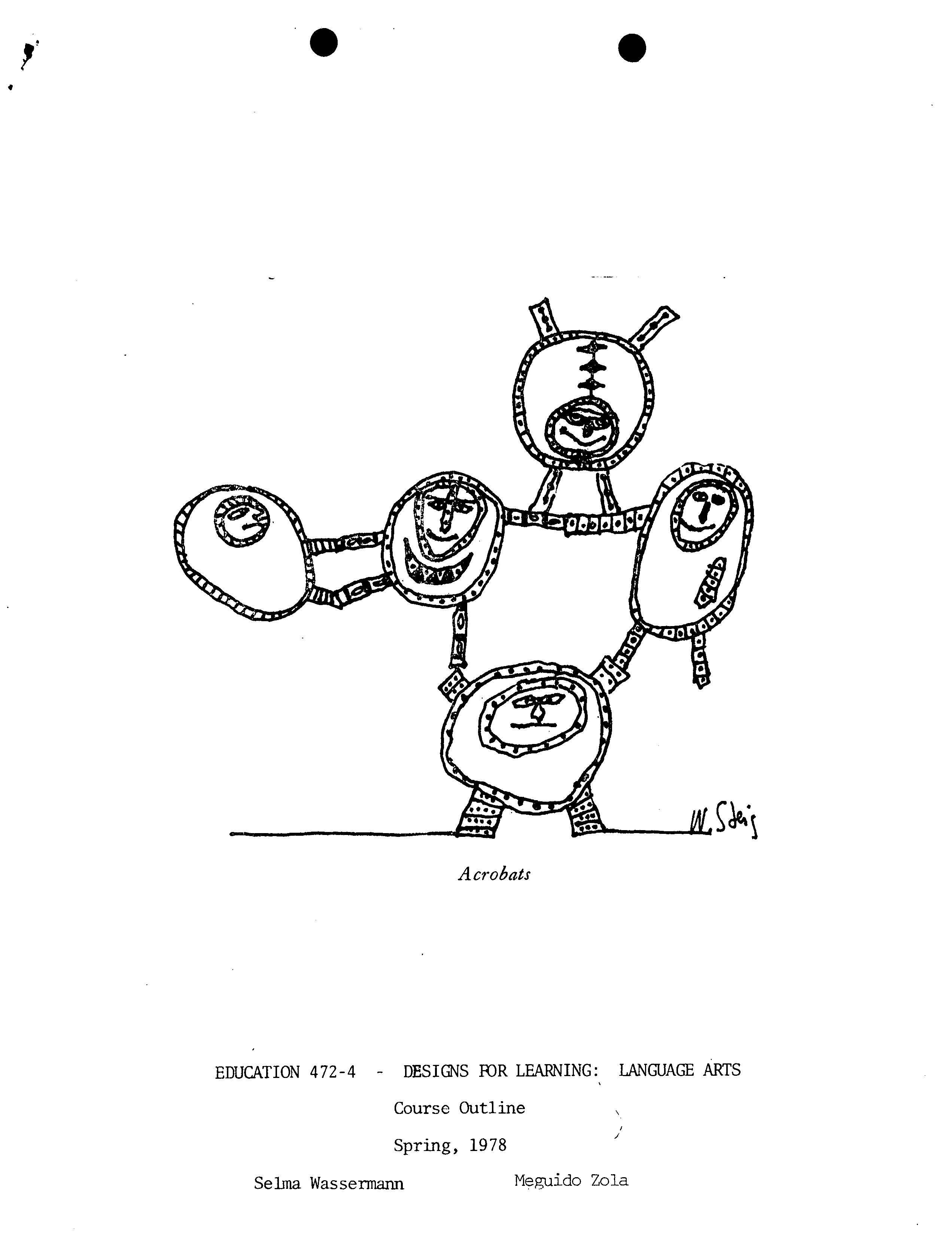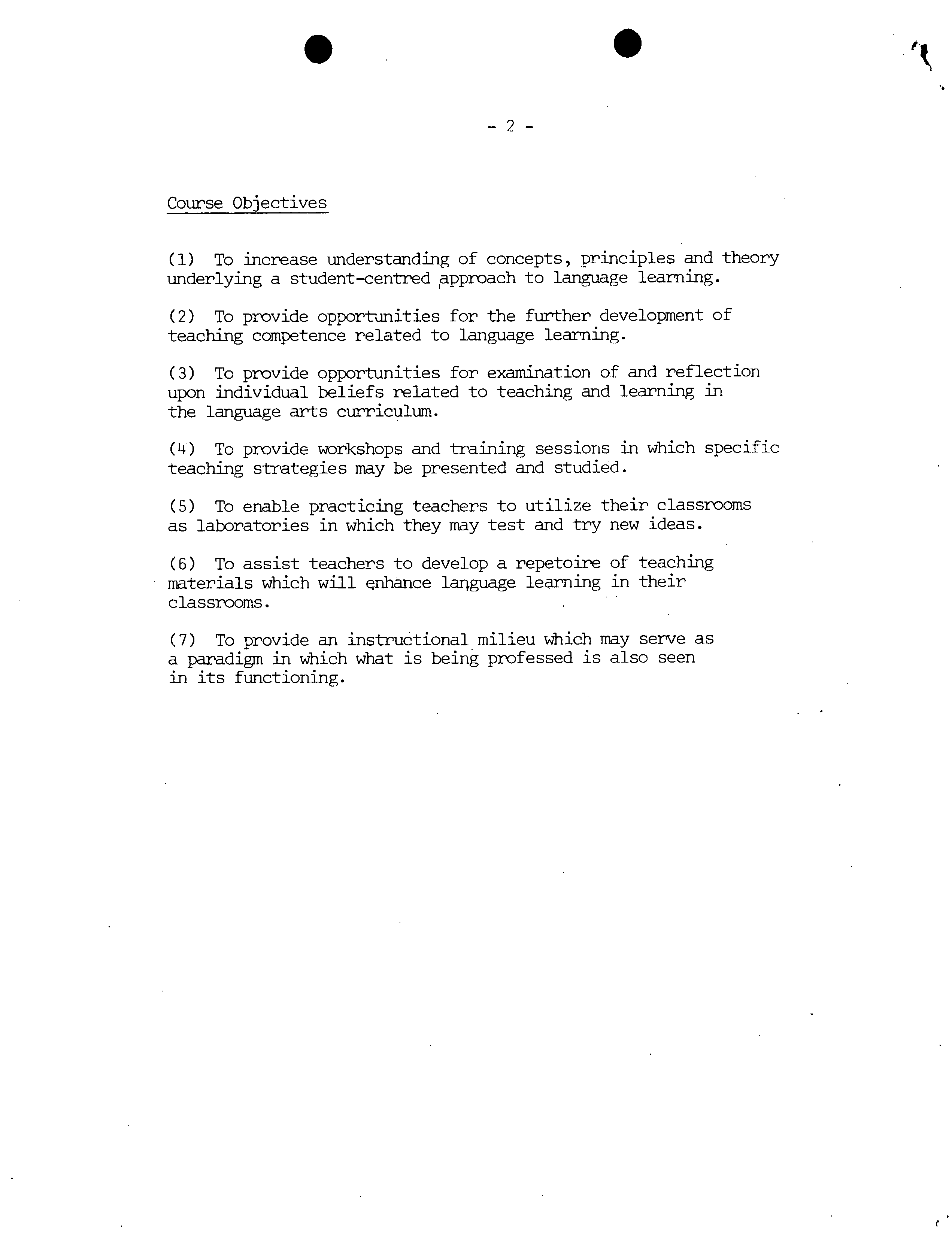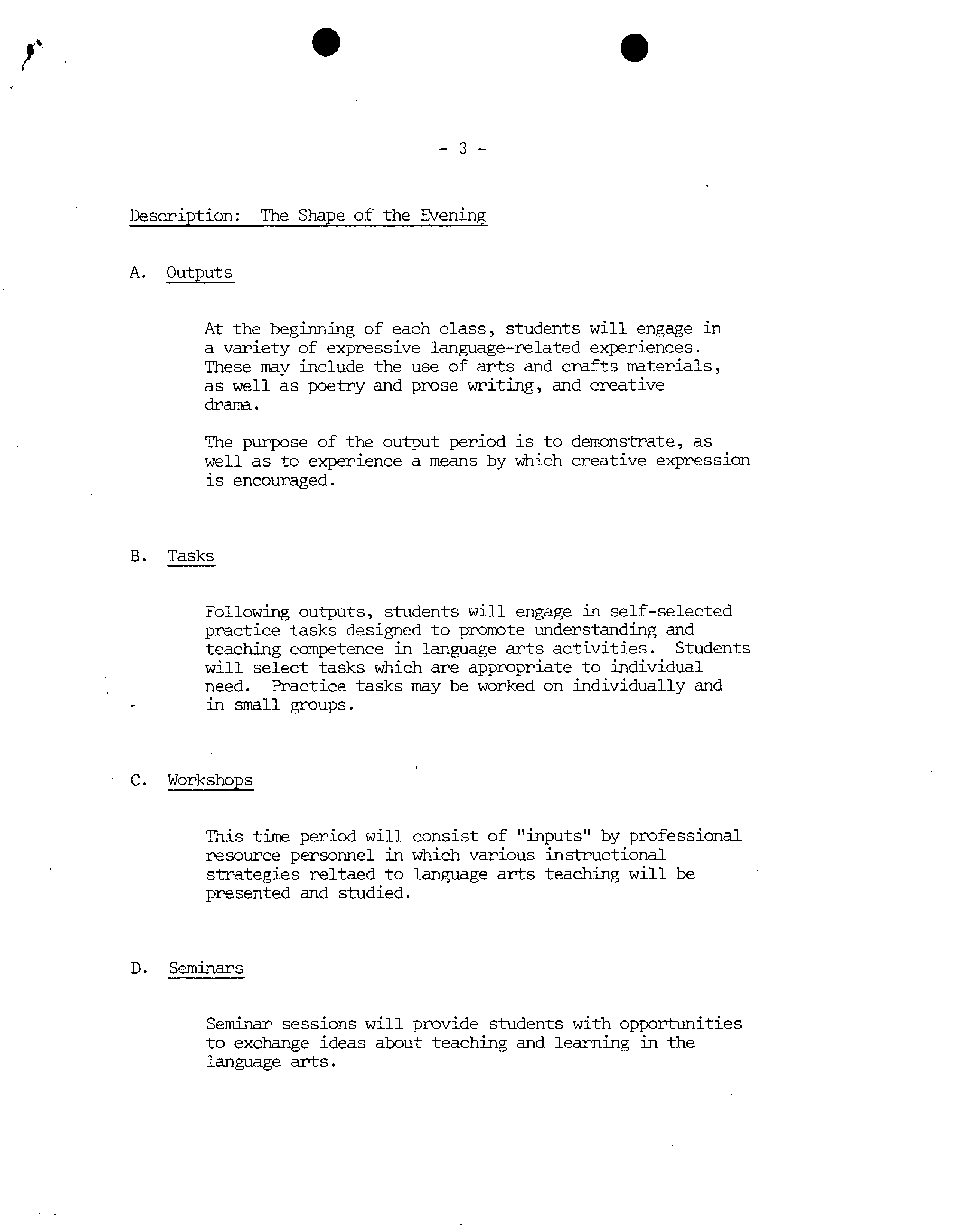SIPWN FRASER UNIVERSIlY
MEMORANDUM
To. .
?
From..
: ?
-
?
Date. .
J
AI C
b
?
(...............................
I
A'
- p ?
1
EDUCATION 472 - DESIGNS FOR LEARNING: LANGUAGE ARTS (ELEMENTARY)
INTERSESSION AND SUMMER SESSION 1978.
Instructor: Marvel Rogers-Dancey
This is a course designed to improve the teaching of Language Arts.
It involves the four major components: Reading, Writing, Listening and
Speaking. The teaching of conventions such as spelling, punctuation and
graimnar will be examined. Other topics addressed include: diagnostic skills,
setting objectives, planning, evaluation, integration of other subjects with
Language Arts, questioning strategies and alternative teaching strategies in
reading.
Required Text:
James Moffett, Betty Jane Wagner. Student Centered Language Arts
and Reading K-13. Houghton-Mifflin, 2nd rev. edn. 1976.
Other texts will be suggested.
MR: ca
.
!7a
1
I'
?
G)
RageyoMemacy
:'a*Ea
2Xt?
r' JCJ(13 S
1fgzX(3r
Betty Jane. ?
tud
ant
?
orC.
Tr
L
wo
'rcs
and
?
J3' ?
O L')tOjjiil'-
ci
rev.od. 196Q
CY r
Cflct TO2.ts
.
Jook,
MOM
.
,
T3trau
Joer.e.
of
?
?
!2'
?
teat n'
?
aer Cl.1cc
JJ?1Si32.I:
Cc1'i
.,
AS
Yok ?
L.
1961
20
?
?
usnotte, For tho
Lc
y
wc
ofToi.chii,. Lit cr- t
Sombuz
Zoo
du:.onaI Dovto
p ;'.ent. nc.no C11f., 113
'•ach. itornolte, Rcaduig in
the
1rietay Schoole
MUM Pross,
£O
YOli
)66
Virgil.
iacL11
g.
Pixbiish1.:ig Co
?
LoxdoQ
i97L.
, :- Kovashh, Ushaso Mosv and
1rems.
York,1970u
.
LLUa ?
(n ?
)
iatoi
R3i:ico
r3 ?
1030
?
:22o
?
.
L
3 O ?
32O
1 ?
co?oErht ?
peiing ii3tiu.n ?
ad.zg
thaLxV
2
?
on of prcgranmv
• ?
:ar!
2O
vobu:ry
JLP, ?
rita ?
Coo..t:1on et aiQ
' Ii
?
dw1:Lzaton . Intagration o L.iig
Jc
?
r1fit2.on
of
T)l 1.
1
,
lo s cJahics cud
?
rent research,
VO1(flt
of iio,itin ?
Lw:
upiJ. 'record kop.'Ln
t:r record koeng
•
Y
.
'r3porting to paon;
iiotic skJ.1i
iaLona3. nd
iiaJ;c ?
iegter
;Ln objoc.vcs
Skili. ci ro1op:iitnt
?
ac')A;1ic
?
:C
'icnir.g 3tatn,ies
2ootry
LEan
Loninpz Styie
r)iDtJ.itie
Lorattrz
Va1us in
?
Arts
Thnk,n S:.iiis
of
Ohi1dei
. ?
S
c
?
a':t
l,
3oi. revi
e
w
?
3po1:C1e paramSerG
2. Tan ?
tt
raad i mg skill
:L43SO
?
.:
:ai
?
projeotu
cc
teac
a&
hing
?
oug
p12
11 ?
ni Qn
'
p
.cthro file
c-.
V30OU11C
WICS
creIc f:t•i: chlldro&E literatu p
s, et
Glans participation anA at
ic
i'c
:
?
:L
?
and c
amplot
ien
of
c Li: ,
. ?
S
EVALUATION CRITERIA--Education 472-1
Final grades are determined by the instructor. They are
based upon two criteriat
1. the degree to which students have
demonstrated fulfillment of course
requirements
2, the quality of the student's work
Possible Grades
A = Outstanding. This will represent outstanding
quality in all aspects of course requirements.
B = Good. This will represent outstanding quality
in the completion of most course requirements
or good quality in the completion of all course
requirements.
C = Satisfactory. This will represent good quality
in the completion of most course requirements
or acceptable quality in the completion of all
course requirements.
D = Poor. This will represent poor quality in the
completion of course requirements.
E = Fail. This will represent unacceptable quality
in student's work and/or lack of completion of
course requirements.
** Plus and minus grades will also be considered.
S
EDUCATION 472 - DESIGNS FOR LEARNING: LANGUAGE ARTS (ELEMENTARY)
INTERSESSION AND SUMMER SESSION 1978.
Instructor: Marvel Rogers-Dancey
This is a course designed to improve the teaching of Language Arts.
It involves the four major components: Reading, Writing, Listening and
Speaking. The teaching of conventions such as spelling, punctñat ion and
grammar will be examined. Other topics addressed include: diagnostic skills,
setting objectives, planning, evaluation, integration of other subjects with
Language Arts, questioning strategies and alternative teaching strategies in
reading.
Required Text:
James Moffett, Betty Jane Wagner. Student Centered Language Arts
and Reading K-13. Houghton-Mifflin, 2nd rev. edn. 1976.
Other texts will be suggested.
MR: ca
7,
?
S. ?
S
Acrobats
EDUCATION 472-4 - DESIGNS }OR LEARNING: LANGUAGE ARTS
Course Outline
Spring, 1978
Selma Wassermann ?
Meguido Zola
S ?
.
Introduction
This course is offered for pre-service and in-service
teachers who wish to explore the teaching of language arts with
a view towards increased understanding of principles as well as
the improvement of classroom teaching performance.
The principles of language arts instruction, outlined
by James Moffatt, will serve as the theoretical framework upon
which the course is based, i.e.:
(1)
A course in language learning is a course in thinking.
(2)
Rendering experience into words is the real business
of a language arts program.
(3)
A student needs most of all to perceive how he is
using language and how he might use it. He there-
fore needs awareness, rather than information.
(4)
The role of the teacher is to help students expand
their cognitive and verbal repetory as far as
possible.
(5)
The best way to provide individual students with
enough language experience and feedback is to
develop a program in which children use language
an enormous amount. That means, children in schools
must talk a lot with each other.
(6)
If the goals of the curriculum are to help learners
think, speak, listen, read and write, to the limit
of their capacities, then the most reasonable way
to accomplish these goals is to insure that children
do a lot of these things in the classroom.
The course will emphasize an approach which taps the inner
life of the child and uses that as working material to promote
cognitive awareness, more sophisticated and aesthetic language
usage, and increased skill in interpersonal communications.
. ?
.
-2--
Course Objectives
(1)
To increase understanding of concepts, principles and theory
underlying a student-centred pproach to language learning.
(2)
To provide opportunities for the further development of
teaching competence related to language learning.
(3)
To provide opportunities for examination of
and
reflection
upon individual beliefs related to teaching and learning in
the language arts curriculum.
( L
t)
To provide workshops and training sessions in which specific
teaching strategies may be presented and studied.
(5)
To enable practicing teachers to utilize their classrooms
as laboratories in which they may test and try new ideas.
(6)
To assist teachers to develop a repetoire of teaching
materials which will enhance language learning in their
classrooms.
(7)
To provide an instructional milieu which may serve as
a paradigm in which what is being professed is also seen
in its functioning.
1
?
.
?
.
-3-
Description: The Shape of the Evening
A.
Outputs
At the beginning of each class, students will engage in
a variety of expressive language-related experiences.
These ma y
include the use of arts and crafts materials,
as well as poetry and prose writing, and creative
drama.
T
he purpose of the output period is to demonstrate, as
well as to experience a means by which creative expression
is encouraged.
B.
Tasks
Following outputs, students will engage in self-selected
practice tasks designed to promote understanding and
teaching competence in language arts activities. Students
will select tasks which are appropriate to individual
need. Practice tasks may be worked on individually and
in small groups.
C.
Workshops
This time period will consist of "inputs" by professional
resource personnel in which various instructional
strategies reltaed to language arts teaching will be
presented and studied.
D.
Seminars
Seminar sessions will provide students with opportunities
to exchange ideas about teaching and learning in the
language arts.
.
?
S
_L_
Course Requirements
1.
Students are required to attend and participate in all parts
of the program.
2.
Students are required to complete the assigned readings.
3.
Students will complete the number of required practice tasks
and demonstrate competency in the completion of those tasks.
Evaluation
Completion of the course requirements form the basis for
evaluation. There are three components in the final evaluation:
(a)
Self evaluation. Students will assess their ful-
fillment of course requirements in a written
self-evaluation report.
(b)
Faculty evaluation. Students will meet with the
instructor in a final interview during which time
student performance will be assessed.
(c)
Grading. Final grades are determined by the instructor.
They are based upon two criteria:
(i)
The degree to which the student has completed
the course requirements;
(ii) The quality of the student's work.
A
?
A grade of A will represent outstanding quality in the
completion of all course requirements.
B = A grade of B will represent outstanding quality in the
completion of most course requirements, or good quality
in the completion of all course requirements.
C ?
A grade of C will represent good quality in the completion
of most course requirements, or acceptable quality in
the completion of all course requirements.
D ?
A grade of D will represent poor quality in the completion
of course requirements and/or lack of completion of
course requirements.
F = A failing grade will represent unacceptable quality in student's
work and/or lack of completion of course requirements.
I
?
.
?
Ll
-5-
Reading List
Required text:
?
Moffett, James
A Student-Centred Language Arts Curriculum,
1I
1'
Boston: Houghton-Mifflin, revised edition, 1976.
Students will select two additional readings from this list:
Ashton-Warner, Sylvia. Teacher. New York: Simon and Schuster, 1963.
Fadar, Daniel. Hooked on Books. New York: Berkeley, 1968.
Harris, Albert. How to Increase Reading Ability. New York: McKay, 1977.
Hayakawa, S. I. Language in Thought and Action. New York: Harcourt and
Brace, 1964.
Lee, Doris, and Van Allen, Roach. Learning to Read Through Experience.
New York: Appleton Century, 1963.
Mean-is, Hughes. Creative Power. New York: Dover, 1959.
Paths, Louis, Wassennann,5eini, Jonas, Arthur, Rothstein, Arnold. Teaching
for Thinking: Theory and Application. Columbus, Ohio: :
Charles E.
ll
Merri
?
Co., 1966.
Richardson, Elwyn. In the Early World. New York: Random House, 1964.
Simon Fraser University mimeo. Individualized Reading.
Veatch, Jeannette. Reading in the Elementary School. New York: Ronald
Press, 1965.
Way, Brian. Drama Through Experience.
Students may also wish to explore the Following related materials,
although none of these is required:
Kaplan, S., et al, CHANGE FOR CHILDREN: IDEAS AND ACTIVITIES FOR
INDIVIDUALIZED LEARNING. Pacific Palisades, California: Goodyear, 1973.
Shaftel, F., and Shaftel, G., ROLE PLAYING FOR SOCIAL VALUES. New
Jersey: Prentice Hall, 1967.
. ?
.
-6-
Lorton, N., WORKJOBS: ACTIVITY CENTRED LEARNING FOR EARLY CHILDHOOD
EDUCATION. 1)n Mills, Ontario: Addison Wesley, 1972.
MAKING IT STRANGE: A NEW DESIGN FOR CREATIVE THINKING AND WRITING.
Synectics, Inc., New York: Harper and Row, 1968.
Koch, Kenneth, WISHES, LIES AND DREAMS.
Koch, Kenneth, ROSE, WHERE DID YOU GET THAT RED.
Veatch, Jeanette, et al, KEY WORDS TO READING. Columbus, Ohio:
Charles Merrill, 1973.
Lewis, Richard, MIRACLES. New York: Simon and Schuster, 1967.
Lewis, Richard, JOURNEYS. New York: Simon and Schuster, 1969.
Griggs, Tamar, THERE'S A SOUND IN THE SEA.
Miel, Alice, INDIVIDUALIZING READING INSTRUCTION. New York: Teacher's
College, Columbia University Press, 1958.
